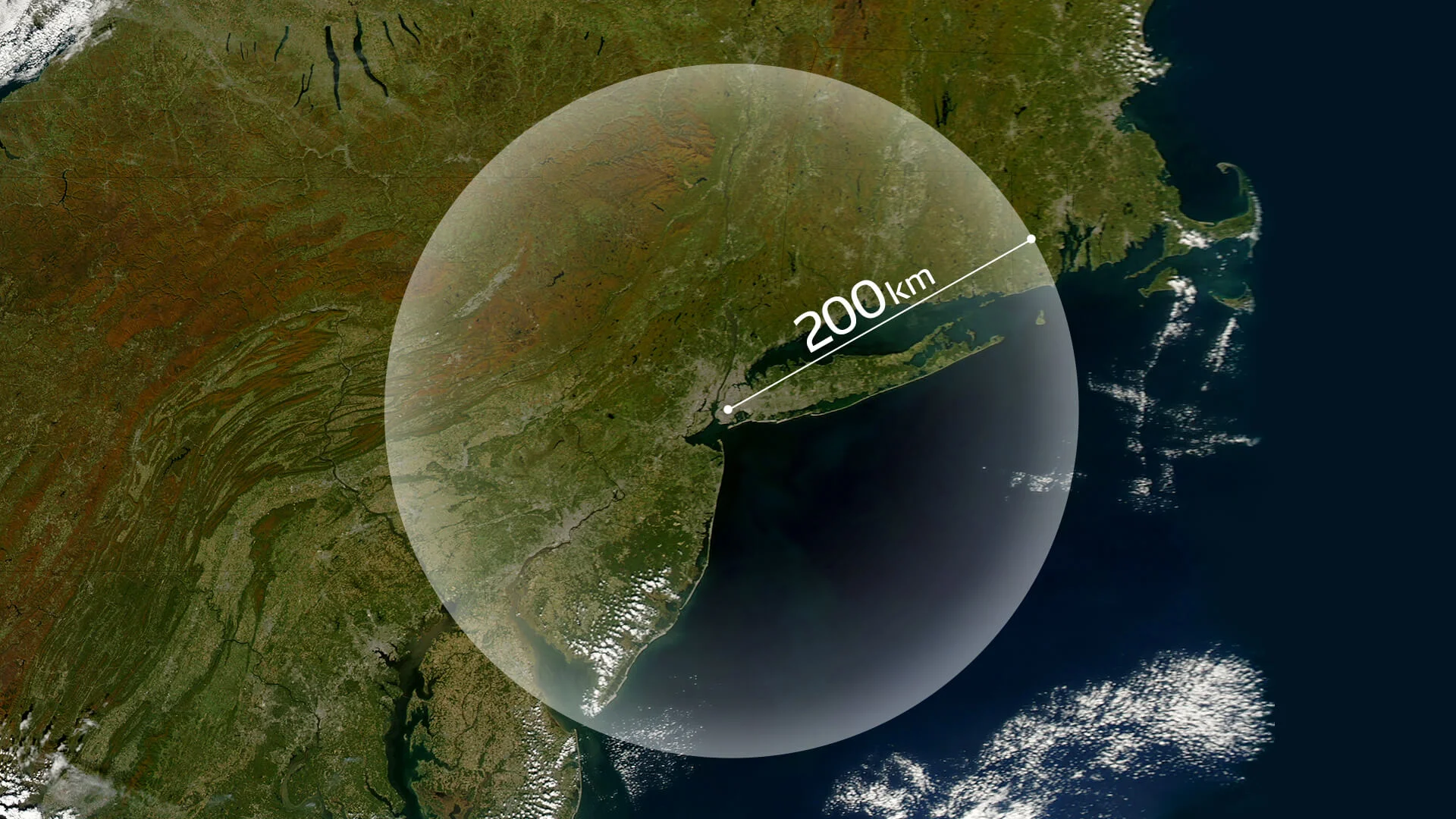

Dec 25, 2020
VISION & IDEABridging the distance an air mobility revolution
Ten years from now, direct point-to-point travel will be the norm, enabling access to anywhere within a 200-kilometer radius in just an hour.
In recent years, expectations have been on the rise for flying cars, a mode of transport that differs from both drones and helicopters. People have long relied on vehicles such as automobiles and trains as their daily means of transportation. By adding flying cars powered by electrification and automation technologies to this mix, we can revolutionize the ways in which we travel from place to place.
Contents of this article
The contradiction of long travel times to nearby destinations
In today’s world, many of the places we want to reach are close yet somehow still far away—physically they are nearby and yet it takes a long time to reach them using our current means of transportation. Compare, for example, a campground that is 200 kilometers away from home and a hotel in a foreign country that is 2,000 kilometers away. Despite these vastly differing distances, the time taken to reach each destination is about the same. Another example is road travel: a distance that normally takes one hour to cover may instead take three hours due to traffic congestion, making this short distance “farther” under actual travel conditions. These close-yet-far contradictions are seen everywhere in current forms of travel.

Contradiction caused by the use of linear paths in transportation networks
The use of linear paths to form contemporary transportation networks is exemplified by the names themselves such as the “Tokyo–Los Angeles route” for air travel, “National Route 1” for road travel and the “Tokaido Shinkansen Line” for high-speed rail travel—all of these are labeled as “routes” or “lines.” To get from place to place, we must follow these linear paths, which together form crisscrossing transportation networks. Such linear-type networks meet the needs of users in some instances, but not in all cases.
In less populous, outlying towns and regions where traffic volumes are low, no air- or water-based travel is available, and even buses and trains come just a few times each day. Because it makes little sense for transportation operators to increase the frequency and coverage for areas where there is little demand, the disparity in transportation availability between outlying areas and urban centers continues to widen, exacerbating the close-yet-far phenomenon.

Transitioning from linear-route movement to direct point-to-point travel
The transportation revolution that will eliminate this contradiction has already begun, triggered by the flying car. These vehicles can be conveniently boarded anywhere and anytime—just like a taxi—and provide personalized, direct transport to a specified destination, putting them in a different category than their cousin, the airplane.
The spread of flying cars throughout society will free us from the need to follow rigid travel routes and lines. No longer will we trace linear paths on a grid; instead, we will be able to move directly from a departure point to an intended destination using the shortest route available. Moreover, airborne routes will not suffer congestion and stoppages like land-based roads. All users will be able to travel freely and efficiently within a radius of about 200 kilometers (125 miles), and the most surprising part is that these flying cars will likely begin whisking us through the skies within the next ten years!
In Europe, efforts are already under way to change legislation related to public road usage permits and the like in order to make these new vehicles a reality. In Japan industry players ar starting projectswith government backing aimed at deploying flying cars in society by 2030 to establish Japan’s global presence in this field. The market for passenger transport alone using flying cars is predicted to be 9 trillion yen worldwide and 650 billion yen in Japan.
Let’s look ahead at the next ten years as we move toward a flying car society.
The novel experience of “driving” through the skies
“Wouldn’t it be exciting to see the autumn leaves from above while flying through the sky?” asks Shingo Nakata, a participant in DENSO’s flying car project at the Eco-mobility Systems Development Division. Despite the fact that we expect to be driving through the skies in just ten years’ time, from today’s perspective it seems a distant prospect, disconnected from modern society. We talked with Nakata about the project itself as well as its potential in view of his hopes.

As Nakata explains, “Flying cars travel using an electric propulsion system, comprised of motors and inverters, rather than a standard engine. Each vehicle is designed as a multi-copter unit with multiple propellers, and is built in such a way that, if one of the propellers were to malfunction or break, the other propellers would enable regular flight to continue. Even if two propellers were to fail, it would be possible to make a safe emergency landing. Above all else, the flying car is a safe means of transport.”
“In addition, a flying car does not require a runway to take off and land, which is one of its most revolutionary features. The vehicle is capable of vertical take-off and landing, and so does not need the large tracts of land required by airplanes. In fact, vehicle takeoff and landing ports can be candidates almost anywhere, even in locations with limited space such as building rooftops”
“Another revolutionary feature of this vehicle type is its low cost, which will allow a larger user base. A helicopter, for example, burns fuel costing tens of thousands of yen in order to cover a distance of 100 kilometers; the flying car is expected to require just several thousand yen to travel the same distance. In terms of maintenance, which is a vital aspect of air travel operations, a motor-driven flying car places a far smaller demand on maintenance staff than an engine-driven helicopter, and costs can be reduced in various areas as a result.”

“Deploying flying cars throughout society will change the way travel looks on a daily basis. For example, traffic jams that occur when people travel to see the autumn leaves at their peak can be avoided by using a flying car, and this has the added bonus of providing views of the fall foliage from above in the sky. Although flying car proponents often tout the vehicle’s travel-efficiency benefits, these vehicles also provide value through the experience of free and liberating flights through the sky.”

Why DENSO is pursuing flying cars
We asked Nakata why DENSO chose to pursue flying cars, and he immediately answered: “The flying car field requires us to make use of the quality-related and mass production capabilities we have built up through automobile-related operations over the years. In the aircraft industry, manufacturers produce only a few hundred planes per year. Flying cars will provide a more casual means of air travel that is readily available at any time, so large numbers of vehicles will be needed. The same amount of quality that goes into traditional automobile and airplane manufacturing is also required for flying cars, and DENSO is skilled at providing such quality even with large production volumes.”

Specifically, DENSO is being asked to provide technologies and expertise related to the motors, inverters and other components that make up the core of flying car systems. These are the motive power sources which make it possible for the flying car to take off and fly, and when developing these components it is vital to minimize the weight, as the final vehicle weight directly affects the maximum vehicle load, fuel efficiency and other performance factors of airborne travel.
The high-output-density motor developed at DENSO achieves both light weight and high power output. It uses a proprietary magnetic circuit design, provides more than double the output-power density of an automobile engine, and contributes greatly to overall weight reductions for flying cars. These benefits will enable more passengers and cargo to be carried, thus raising the value of the vehicle. DENSO also strives to maximize energy savings in vehicle operations through the propulsion system design. The inverters use silicon carbide power elements and provide both high efficiency and high driving frequency, and together with the motor units they contribute to a lighter propulsion system.
In these ways and others, DENSO is refining and developing its technologies to achieve higher performance in airborne mobility, which has the added benefit of enabling better land-based cars in the future as well. Meanwhile, mass-production technologies and cost-saving measures developed in the automotive industry can be applied in the field of flying cars in the future.

A dream project, but also a project facing a vast number of challenges
Nakata added: “An air traffic accident could be fatal, which is why the current air systems adhere to strict rules and laws. To make sure that flying cars are also free from accidents, it is necessary to respect the values behind each law and regulation, and to make sure they are suited to the intended goals. In order to achieve these goals as quickly as possible, inter-industry collaborations and co-creation efforts together with partner organizations are critical. Moreover, these efforts will not stop once flying cars have been successfully completed and deployed. Consider, for example, the potential use of flying cars as a means of public transport, without any vehicle operator onboard: how can one guarantee safety and peace of mind for passengers? What about baggage inspections, and issues such as air traffic control rules? In order to succeed in the flying car revolution, issues beyond the vehicles themselves must also be considered.”
“The various services, frameworks and other aspects of the overall transport system are of the utmost importance, and connected technologies developed in the mobility field, automated driving technologies (which include sensors and artificial intelligence), and other technologies developed by DENSO can be applied to achieve safety and peace of mind for this new generation of transport. DENSO also possesses the know-how and experience in technologies used to deliver optimized user comfort, privacy, security improvements and more, which contribute to the overall user experience. Currently, DENSO is pursuing new possibilities in all of these areas.”

Revolutionizing transport for people everywhere
Back in the days when horse-drawn carriages were the norm, people were amazed when the first automobiles appeared on the streets. However, people soon realized that a new level of convenience had entered their lives, and it took just ten years for the automobile to replace the horse-drawn carriage as society’s primary means of transport.
Today, we stand on the verge of the transition from ground to airborne travel. Pursuing new possibilities in transport will start a revolution in society, and in the coming decade our travel options will become more open and accessible, while mobility becomes more comfortable for each user.
We look forward to the opportunity to experience this new type of travel. DENSO’s ability to turn such ideas into reality will forever change the way people everywhere travel from place to place.
REACTION
Changing your "Can'ts" into "Cans"
Where Knowledge and People Gather.



Leave a comment